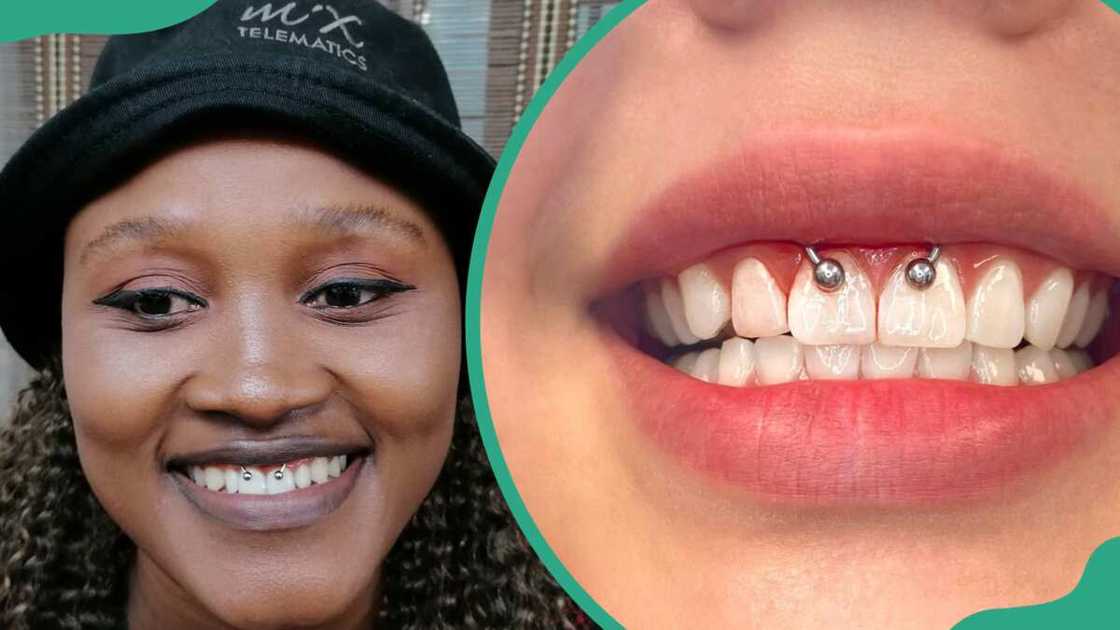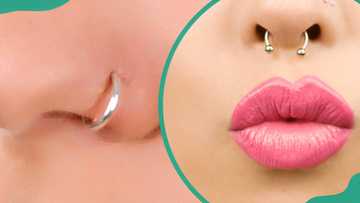Smiley piercing: What you need to know before you get one
Smiley piercings are among the most fashionable and original piercings of the moment, suitable for both women and men. The best part about smiley piercings is their unique sense of style. They combine fashion and self-expression in a way that nothing else can. This post has everything you need to know about the smiley piercing before you decide to get one.

Source: UGC
TABLE OF CONTENTS
Today, smiley piercing is gaining popularity and is frequently regarded as an alternative piercing style perfect for those who want something unique. This piercing involves inserting a piece of jewellery through the frenulum, a tissue section connecting the upper lip's upper part to the gums. It is the best choice for those who desire a piercing that they can hide because it is usually hidden unless you smile.
What is smiley piercing?
Smiley piercing, also known as the frenulum piercing, is an oral piercing that goes through the frenulum, the small, thin piece of skin connecting your upper lip to your upper gum. As the name suggests, it will mostly be seen when you smile.
This type of piercing is perfect for those who want a more low-key oral piercing than other lip and mouth piercing variations. However, unknown to many, the procedure does not work for everyone. The frenulum is thin, posing a greater risk of being torn or rejected. Therefore, it is important to know everything before opting for this process.
Smiley piercing pain level

Source: UGC
Does a smiley piercing hurt? There is generally minimal pain during a smiley piercing. This is because the frenulum tissue is rich in nerves. Since it is very thin, the procedure is very fast, and the sharp pain is short, lasting only a few seconds. However, pain tolerance and thresholds may vary from person to person.
Smiley piercing healing time
The healing process for a smiley piercing can vary from person to person, but if there are no complications like infection, it normally heals within 4 to 12 weeks. If you don’t follow your piercer’s aftercare recommendations, your piercing may take longer to heal.
How are smiley piercings done?
The actual procedure is relatively quick, lasting a few minutes at most. The procedure involves the steps below.
- You will need to rinse your mouth with an antimicrobial mouthwash.
- After your mouth is clean, the piercer will pull your upper lip back to expose the frenulum.
- The piercing will use a sterile needle to make the piercing.
- Once the piercing is made, the piercer will place and fix the jewellery of your choice through the hole made by the needle.
Smiley piercing aftercare guidelines

Source: UGC
Below are some of the essential aftercare guidelines for a smiley piercing to ensure proper and quick healing and avoid risks and complications:
- Do not use aggressive toothpaste to clean your teeth. Softening the flavour will help prevent bad breath.
- Brush your teeth regularly while practising care around the new piercing.
- Clean the piercing 2 to 3 times daily with a piercing aftercare saline solution.
- Be careful when you eat. The location of the smiley piercing might pose a learning curve.
- Stop smoking and drinking alcohol.
- No kissing.
- Stick to soft foods as you get used to the jewellery.
- Avoid spicy and acidic products such as oranges, tomatoes, and sauces. These will irritate the piercing and cause discomfort.
- Wait to change the jewellery until the piercing has fully healed.
- Eliminate unnecessary touching of the puncture site by both the tongue and the hands;
- No chewing gums, and do not drink through the straw.
Smiley piercing risks
Smiley piercings are done on a sensitive area, requiring adequate care; otherwise, they can lead to infection and cause adverse effects. Possible risks associated with smiley piercings include:
- Rejection: Your body might push the piercing out over time due to factors like tissue sensitivity.
- Infection: The bacteria in your mouth may infect the piercing, preventing it from healing properly.
- Gum damage: If your piercing is incorrectly placed, it may cause gum recession over time.
- Speech difficulties: Speech difficulties can arise temporarily after getting a smiley piercing until you get used to it. Pain and swelling could worsen your speech difficulties.
- Smiley piercing teeth damage: The piercing jewellery could knock against your teeth, damaging the enamel and chipping or cracking the tooth in severe cases.
- Allergies to metal jewellery. This particularly happens when surgical-grade metal is not used. People with metal sensitivity will usually notice symptoms from the start.
- Enamel damage: Large beads and other attachments on the jewellery can knock against your teeth, potentially damaging the enamel.
While the above risks are normal for any new smiley piercing, other signs and symptoms could show more serious health concerns. See your piercer if you notice any of the following signs of infection or rejection:
- Continuous bleeding
- Redness that extends beyond the piercing site
- Discharge from wound fluid or pus
- Severe Itching
- Bad breath
- Severe oedema
- Severe itching
- Severe pain
- Severe swelling
Smiley piercing pros and cons
Although the location of the smiley piercing makes for a super cute look, it also has advantages and disadvantages that you should be aware of before committing to it.
Pros:
- They can be easily removed and replaced
- Emphasizes the beauty of a smile
- Quick and relatively low-pain procedure
- Looks unusual and aesthetic
- Invisible until you smile, which may be important under a strict dress code
Cons:
- The piercing can reject or migrate over time
- Requires careful oral hygiene
- Potential for gum or tooth irritation
Smiley piercing jewellery styles
The material used for smiley piercing jewellery includes:
- Barbell: Barbells normally have a horseshoe-shaped barbell with a bead on both ends to hold it in place.
- Seamless ring: A seamless ring is a plain ring without any beads to keep it in place.
- Bead ring: A bead ring is one of the most commonly used smiley-piercing jewellery. It is a circular ring, with a detachable bead at one end to hold it in place.
- Circular barbell: Circular barbell jewellery is also a popular option. The two beads at the end really make this piercing stand out when you smile.
Smiley piercings are vulnerable to infections while they are still new. It is important to use high-quality, hypoallergenic materials to minimise the risk of irritation or infection. The most commonly recommended materials are surgical titanium, surgical stainless steel, niobium, and gold.
How painful is a smiley piercing?
A smiley piercing generally causes minimal pain since it pierces thin tissue quickly. Pain levels vary, but most people find it less painful than other piercings.
What is the purpose of a smiley piercing?
A smiley piercing is mostly for aesthetic purposes. It is a way to express personal style and add an aesthetic element to one's appearance.
How long does the smiley piercing last?
A smiley piercing can last for many years if properly cared for. However, because of the tissue's delicate nature, it may finally reject or migrate over time. Regular maintenance and good oral hygiene can help extend its lifespan.
The smiley piercing is a great option for people who need an extra bold look daring. Above is everything you would love to know about the smiley piercing. But before you undertake the procedure, getting consent from a professional is advisable. Besides, people with too small of a frenulum, braces, gum diseases, and dental sealants are usually discouraged from taking the procedure.
Legit.ng recently published an article about septum piercing. Piercings offer a fun and reversible option to change your appearance and self-expression. Unlike the steel hoops of the past, contemporary septum piercings are simple, subtle, and favoured by celebrities like Zendaya and Florence Pugh.
Septum piercings, which go through the cartilage between your nostrils, have increasingly become mainstream. They were once only associated with punks and cartoon bulls but have become popular partly because celebrities sport them. Read more about it in the article.
Source: Legit.ng








